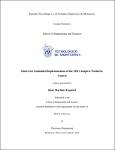| dc.contributor.advisor | Avila Ortega, Alfonso | |
| dc.contributor.author | Martinez Esquivel, Rene | |
| dc.creator | AVILA ORTEGA, ALFONSO; 31866 | |
| dc.date.accessioned | 2021-09-26T23:14:30Z | |
| dc.date.available | 2021-09-26T23:14:30Z | |
| dc.date.created | 2020-05-10 | |
| dc.date.issued | 2020-05-10 | |
| dc.identifier.citation | Martínez Esquivel, R. (2020). Dual-core embedded implementation of the SISO adaptive predictive control (Tesis de Maestría). Instituto Tecnológico y de Estudios Superiores de Monterrey. Recuperado de: https://hdl.handle.net/11285/639382 | es_MX |
| dc.identifier.uri | https://hdl.handle.net/11285/639382 | |
| dc.description | Favela Contreras, Antonio | es_MX |
| dc.description.abstract | The SISO Adaptive Predictive Control (APC) algorithm is implemented on a Dual-Core embedded
system. The Predictive control strategy is implemented on one of the cores available
on the ZYNQ processing system, and the Adaptation Mechanism is implemented on the second
core. The implementation can be thought of as two independent applications running simultaneously.
However, these are not completely independent. The Predictive Control model
is updated on every sampling interval with new parameters generated by the Adaptation mechanism
that better fit the response of the system under control. To correctly synchronize the two
applications, a Master-Slave architecture was chosen for the communication between the two
cores. The core running the predictive control algorithm was assigned the role of the master
because it had a longer execution time for every sampling period. This first core acted as the
master and orchestrated the flow of data between the two cores and the actions taken by the
second core. The second core, which computes the adaptation mechanism, acted as the slave,
as it only performed operations when it received a message from the first core at specific times
during a sampling period. Further optimization was achieved by using in-line Assembly code,
which makes it possible to take advantage of the processor architecture and implement optimal
subroutines for a particular application. The low-level optimizations improved execution
time by reducing clock cycle counts and reducing the use of external memory for temporary
variables. These optimizations resulted in a speedup of up to 3x when compared to the latest
embedded implementation of the APC algorithm reported in the literature. | es_MX |
| dc.format.medium | Texto | es_MX |
| dc.language.iso | eng | es_MX |
| dc.publisher | Instituto Tecnológico y de Estudios Superiores de Monterrey | es_MX |
| dc.relation.isFormatOf | versión publicada | es_MX |
| dc.relation.isreferencedby | REPOSITORIO NACIONAL CONACYT | |
| dc.rights | openAccess | es_MX |
| dc.rights.uri | http://creativecommons.org/about/cc0/ | es_MX |
| dc.subject.classification | INGENIERÍA Y TECNOLOGÍA::CIENCIAS TECNOLÓGICAS::TECNOLOGÍA ELECTRÓNICA | es_MX |
| dc.subject.lcsh | Technology | es_MX |
| dc.title | Dual-Core embedded implementation of the SISO adaptive predictive control | es_MX |
| dc.type | Trabajo de grado, Maestría / master Degree Work | es_MX |
| dc.contributor.department | Ingeniera Electronica | es_MX |
| dc.subject.keyword | Embedded | es_MX |
| dc.subject.keyword | Dual-Core | es_MX |
| dc.subject.keyword | APC SISO Control | es_MX |
| dc.contributor.institution | Campus Monterrey | es_MX |
| dc.contributor.cataloger | tolmquevedo, emipsanchez | es_MX |
| dc.description.degree | Maestria | es_MX |
| dc.audience.educationlevel | Investigadores/Researchers | es_MX |
| dc.relation.impreso | 2020-05-08 | |
| dc.identificator | 7||33||3307 | es_MX |



